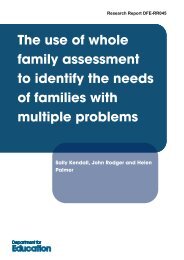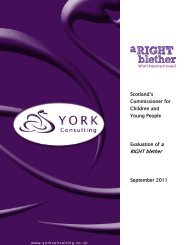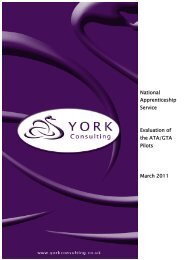Recruitment and Retention in the Post-16 Learning and Skills Sector
Recruitment and Retention in the Post-16 Learning and Skills Sector
Recruitment and Retention in the Post-16 Learning and Skills Sector
You also want an ePaper? Increase the reach of your titles
YUMPU automatically turns print PDFs into web optimized ePapers that Google loves.
5 TURNOVER, VACANCIES AND HARD TO FILL VACANCIES5.1 In this section, we explore issues relat<strong>in</strong>g to vacancies <strong>and</strong> hard to fillvacancies across <strong>the</strong> post-<strong>16</strong> learn<strong>in</strong>g <strong>and</strong> skills sector. These arecovered under <strong>the</strong> follow<strong>in</strong>g head<strong>in</strong>gs:• turnover• vacancies;• recruitment difficulties;• response to recruitment difficulties;• factors caus<strong>in</strong>g hard to fill vacancies.Turnover5.2 The HR managers survey determ<strong>in</strong>ed that, over <strong>the</strong> past year, a total of5,511 teach<strong>in</strong>g staff have left <strong>the</strong>ir jobs with<strong>in</strong> <strong>the</strong> colleges surveyed.This represents a turnover figure of 10% for <strong>the</strong> year. This compareswell with turnover figures identified for <strong>the</strong> o<strong>the</strong>r parts of <strong>the</strong> economy,such as <strong>the</strong> national average across all sectors of <strong>16</strong>%, accord<strong>in</strong>g to <strong>the</strong>Chartered Institute of Personnel Development 5 .5.3 Turnover <strong>in</strong> secondary schools was 12.5% between 1998 <strong>and</strong> 2001 <strong>and</strong>14.7% <strong>in</strong> primary schools (DfES, RR640, 2005).Table 5.1: Turnover of Teach<strong>in</strong>g Staff<strong>in</strong> FETotal teach<strong>in</strong>g staff 53,879Total teach<strong>in</strong>g staff leav<strong>in</strong>g 5,463Turnover rate 10%Base 174 Institutions supply<strong>in</strong>g complete staff<strong>in</strong>g numbersSource: YCL/MORI quantitative survey of FE HR managers, 20055.4 Large <strong>in</strong>stitutions tend to have a slightly lower rate of turnover (8%)compared with all o<strong>the</strong>r groups (small-11%, small/medium-12%,medium/large-10%). Unsurpris<strong>in</strong>gly data showed that permanentteachers, who form <strong>the</strong> bulk of most <strong>in</strong>stitutions staff, accounted for <strong>the</strong>largest proportion of staff choos<strong>in</strong>g to leave <strong>in</strong>stitutions.5.5 Just under half of colleges (49%) <strong>in</strong>dicated that <strong>the</strong>y regularly collectdata on leaver’s dest<strong>in</strong>ations.5 In 2003, accord<strong>in</strong>g to <strong>the</strong> CIPD's annual survey, <strong>the</strong> overall employee turnover rate for <strong>the</strong>UK was <strong>16</strong>%, http://www.cipd.co.uk/subjects/hrpract/turnover/empturnretent.htm36











